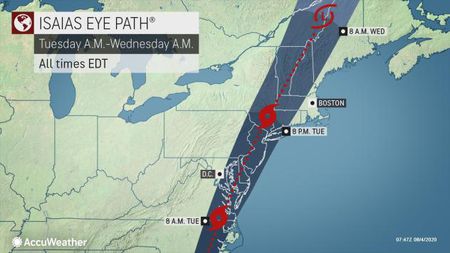
Note: This post contains some affiliate links to products used.
Tropical storm Isaias barreled up the Hudson River valley on August 3rd and took out power for over 1.4 million utility customers. Below are the experiences and lessons from two households that deployed their preps to cope.
One household, mine, is in New Hampshire, which saw about 75,000 homes lose power during the night. The other household is my son’s in Connecticut, that had around 700,000 homes without power. Both houses had some successes and some revealed room for improvement.
In New Hampshire

That Monday was a day of steady rain and very strong wind. By nightfall, the rain had stopped but the wind continued to roar in the tree tops. For some reason, I woke up around 2:00 just before the power went out. I heard a deep “chung” sound from up the road. Something had blown at the substation, things got a little darker than 2 a.m. typically is.
This was not our first power outage. We had coped through several outages before this. I knew the freezer and fridge would be fine for a few hours so I let myself go back to sleep.
Around dawn, I hauled up the generator and the long extension cords. The rain had stopped, thankfully, so I did not have to rig up a cover for the generator. I ran it for an hour, knowing that the fridge needed to do some extra cooling-down.
In Connecticut
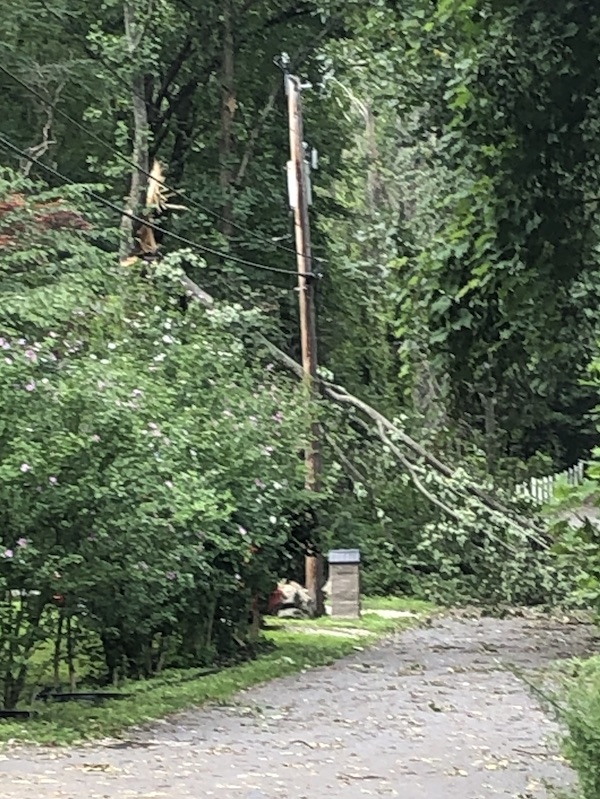
My son’s neighborhood was among the 700,000 that lost power that Monday night too. Early the next morning, he too set up his generator and ran cords. We traded texts about what an optimum runtime to rest-time ratio might be. Both father and son households were up and running on plan B. With both our fridges provided for, we turned our attention to other vital needs.
Coffee!
Outages are easier to cope with if you’ve got your morning coffee. We both also set to making coffee off-grid. I dusted off the old enameled percolator and set it up on the gas grill’s side burner. My son broke out a gift from his mother-in-law — a Jet Boil set. It was supposed to be for camping but since the birth of their son, there had been no time for camping. He got a quart of water to boil and made his morning coffee using his French press. I enjoyed “cowboy coffee.”
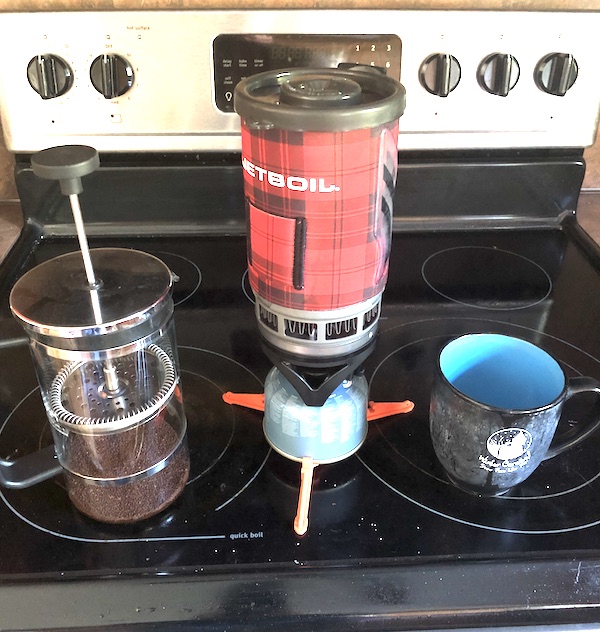
Cooking

We both had gas grills on our decks. Mine has a side burner, making it an easy alternative to the range top. My son’s grill has no side burners but my daughter-in-law learned her way around their gas grill for where the hot spots were.
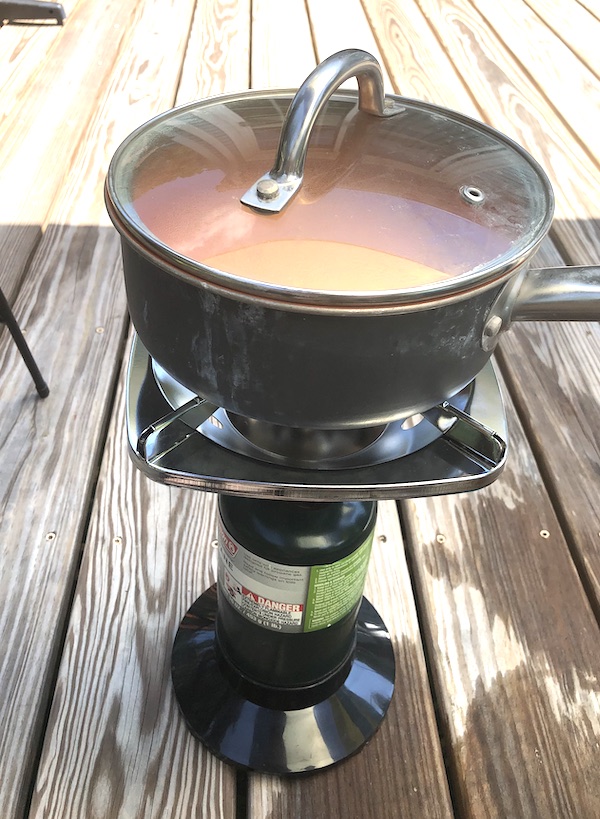
To boil water for pasta, my son used his Coleman tank-top burner (another camping item that doubles as a prep). He got a Mr. Heat Buddy space heater as a backup heat source if there was a winter outage. It takes the same 1 lb. propane tanks, so he had alternate cooking fuel. Soon enough, cooking outdoors on the grill became the new normal for both households.
Water
My house in New Hampshire house has a well (and electric pump), so the loss of grid power means no running water. I installed a hand pump over the well, so we still had water. Well water by the bucket is, however, more work. A clean bucket got filled from the well via the hand pump and brought up to the house. Water is heavy, so it was seldom more than half a five-gallon bucket per trip.
My son’s house is on a public-private water system with emergency generators for their pumps, so he still had water running from his faucets. His water problem was the sewer.
Limiting Waste
Since our house in New Hampshire has a gravity-fed septic system, we don’t need electricity to flush safely. We used rain barrel water for flushing.
My son’s house, however, has an electric pump that pushes the waste water up from the holding tank to the leech bed. He had all the clean water he wanted but he was limited for how much waste water could go down his drains. If they filled their septic tank, it would back up into the house — in the heat of August.
To forestall that terrible fate, they limited flushes. (“If it’s yellow, let it mellow…”) They washed dishes and laundry outdoors. Soapy ‘gray water’ was then poured in different places around the edges of his yard.
NH Restored
Tuesday evening, I was going around the house getting the evening lighting alternatives ready: flashlights positioned in every room and the brighter LED lamps to run off the battery bank for the living room. Then, the power came back on.
I have to confess to a little disappointment when the power came back on. Every outage provides a learning experience so I was bummed that the lesson was over so soon.
That was not the case at my son’s house. He remained without power for a week. Things got tougher for him. His experience provided many lessons.
Improvised Hot Water
Without their home’s water heater, and not wishing to expend his limited supply of propane heating up wash water, my son improvised with his garden hose. He laid it out in the yard, in full August sun. It did not take too long for his black hose to heat up the water inside it. The hose might have held only a couple gallons but it was enough hot water for washing dishes or clothes, or themselves.
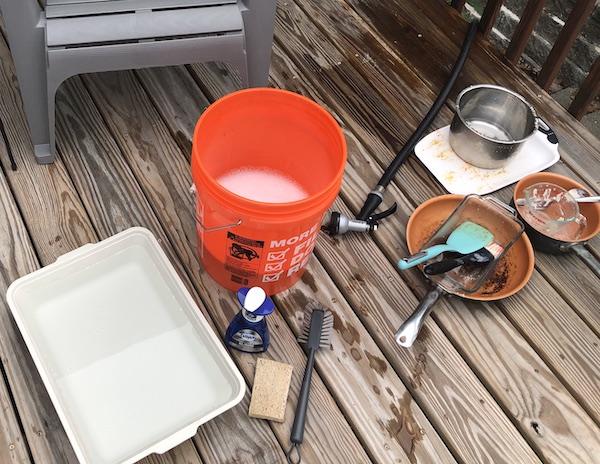
Note the black garden hose that supplied the hot water.
They used hose-heated water for their sponge baths. The gray water was saved in buckets rather than go down the drain, lest it overfill their septic reservoir. Life seemed to be settling into a new (manual labor) routine. That is, until…
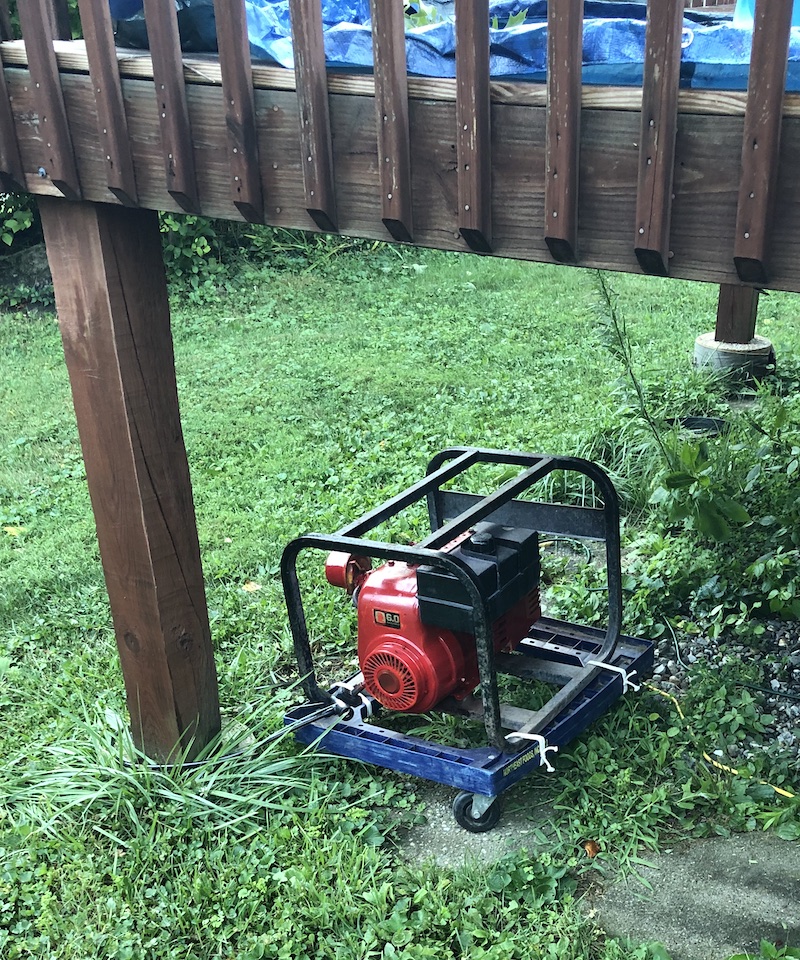
Disaster Strikes!
On the third day, his generator died. He thought it sounded like it was running louder and harsher. As he went to investigate, it stopped dead. Attempts to restart it failed. He investigated but he could not find anything obvious (or quickly fixable). The mechanic friend who built the generator (he runs a small-engine repair business) felt bad at the failure and picked up the unit right away. Unfortunately, the prognosis was a broken piston rod. It would not be fixed anytime soon.
Enter Plan C
Having listened to some Steven Harris interviews on TSP years ago, my son had a 1,000-watt inverter on hand. He got it to be his Plan B backup for his previous home. After the purchase of the little red generator, the inverter became Plan C. It came in very handy post-Isaias. He used his cars as generators.
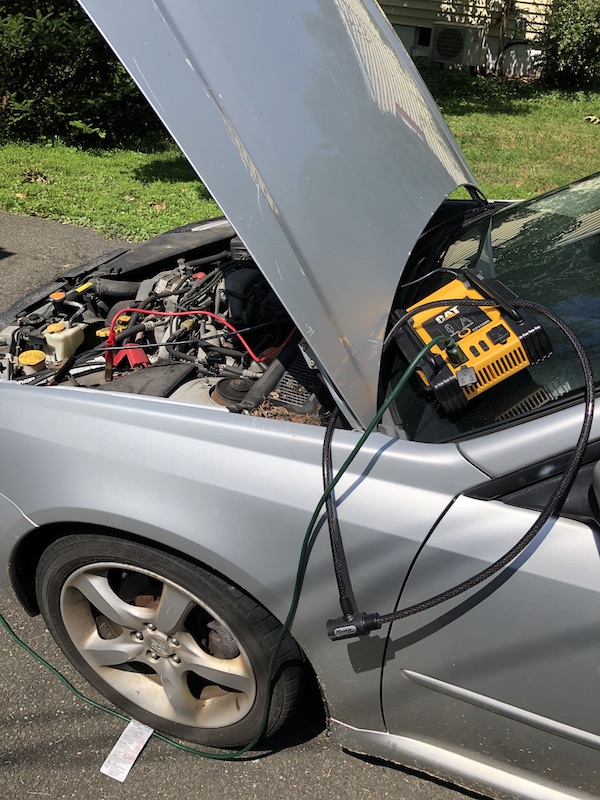
He went into town to fill up their cars’ gas tanks. With so many people running generators, there were long lines at the major gas stations that were operating on their own generators. Curiously, there was no one at the out-of-the-way Stop n’ Shop gas station. He had all eight pumps to himself. Chalk one up for out-of-the-way resources. And, a reminder to keep gas tanks at least half full.
Using his car’s alternator as power source, the inverter provided power for his two refrigerators. Using an in-fridge thermometer, he could tell that an hour of run and two hours off was not enough. His fridges were not getting down to proper temperature. An hour of run every other hour was working but it meant being alert almost all the time.
To forestall mischief, (especially in the wee dark hours) he used a long bike cable lock to tie down his inverter to his car. He slept on the couch with an alarm to wake him every hour and a half to get up and run the car and inverter. He said that the waking up a lot during the night reminded him of when their son was an infant. Except this time, it was twins (two refrigerators) that had to be fed.
The cars and inverter worked well enough, if not particularly efficient for fuel use. Running them every other hour or so became a bit tedious as a routine.
Improvised Washing

Using his new hose-water heating method, my son did the daily dish washing on his deck with a bucket of warm sudsy water. He did laundry on the deck too, using a 5-gallon bucket and a broom handle as an agitator. A bucket-full (roughly eight clothing items) was a bit of a physical chore so he only laundered the essentials. They dried on the folding rack. The summer sun was useful that way.
The Novelty Wears Off
For the first couple of nights, my son and his wife stayed up, playing board games and talking between generator runs. After the generator died, the routine was taking a toll. Each day seemed to have plenty of tasks and chores. Sleep became precious. No more board games.
Oblivious Toddler

My son and his wife had decided early on that their child was not going to be addicted to screens. They limit how much TV he sees and don’t let him play with functional phones. Instead, they read him books and play with physical toys. As such, the power outage had zero impact on the little boy’s life. Blocks still stacked, books still had pictures. There was food on his plate and warm-ish water for his bath. Little changed.
I joked that since my son and his wife did not freak out about the outage, but instead shifted calmly into plans B and C, their child would have no particular memory of the event. Life, for him, went on pretty much as it always had, as far as a little boy was concerned.
Lessons Learned
My son came up with six lessons he learned from his week without power.
1. Check generator oil when it’s off. Generators without a low-oil shutoff should be checked regularly during extended running, but only when the engine is off. He thinks he ran it low on oil, but he mistook splash on the dipstick for sufficient oil.
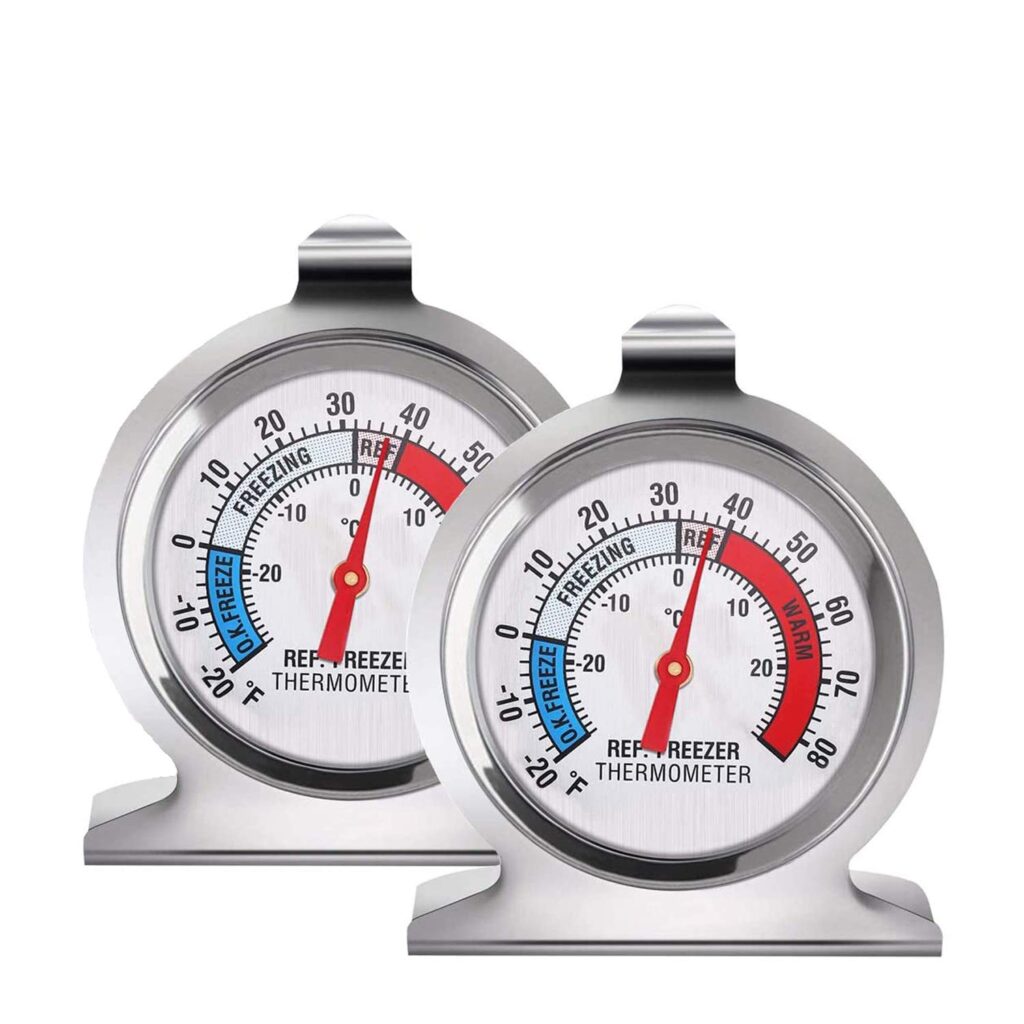
2. Fridges need to run longer than you think. He had internal thermometers so he could see how slowly they were cooling down. I took this lesson to heart and bought a pair of fridge and freezer thermometers from Amazon. $7 for the pair. Cheap insurance.
3. Thermal mass helps: He wished he had kept more thermal mass in his second fridge. Fifty pounds at 35° takes longer to warm up that twenty pounds at 35°. He had many gallon jugs of emergency water on the shelf nearby that could have been thermal mass on otherwise empty fridge shelves. He now keeps them in the fridge to act as thermal mass.
4. Have at least one box fan: Their house has central AC but when that went out, they had no way to cool off. Even a small 12-volt fan would have felt great.
5. Have buckets! He had a couple of buckets on hand but had no idea how handy they would be for moving water around, doing laundry, bathing, etc. I can second that. We keep many buckets. We have “gray” buckets for flush water and washing. We keep a few white food-grade buckets clean, reserved for drinking water only.
6. Headlamps are wonderful. Using his headlamp (a Christmas gift from Dad) made his nightly chore of hooking up his inverter to the car much easier. He could use both hands!
After a week without power, my son learned a lot about the state of his preps. He knows what worked well (the Jet-boil tops his list, along with headlamps), and what did not. The experience has opened his eyes to what more goes into an off-grid lifestyle. He’s making changes to his preps so he will be even more ready for the next event.
Epilogue
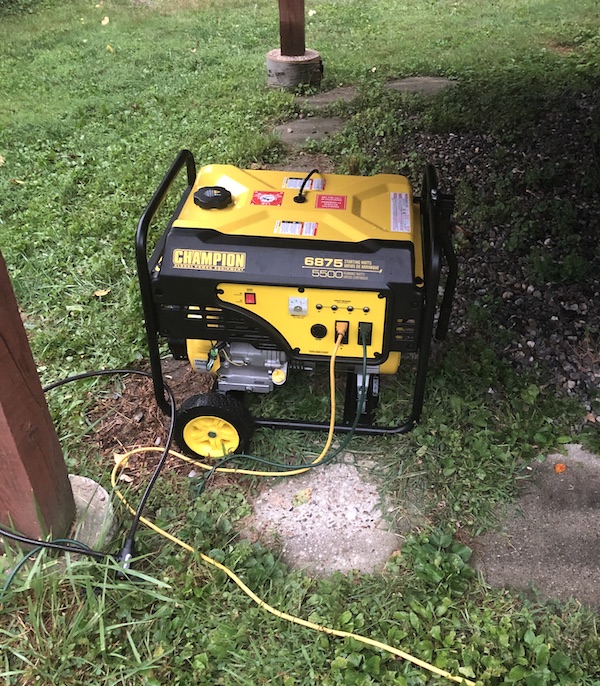
The parts to repair the broken generator were not showing up quickly. So, my son bought another generator — this one with a low-oil shutoff. He got to deploy his new unit shortly after purchase when his power went out again. This time, it was for less than a day, but he was ready. Even that brief outage gave him a good field test of the new unit.
When his mechanic friend gets the little red one repaired, my son plans is to keep it. The red one can be a backup to his backup or it can be a loaner to a neighbor in need. This, he reasons, will build good will (always a good thing). While he intends to keep mum on the extent of his own preps, a fridge-saving loan can be an opportunity to foster the idea of greater preparedness in the neighbor(s).
—

This was a great article. It made me think of having backups to the backup.
Hi Jose,
I’ve been working on some levels of redundancy too. Got the generator as Plan B. Got an inverter for Plan C (using one of the vehicles), then some small-scale solar as Plan D (still using inverters). Each has its limitations. Good to have alternatives.
Good article. I live on the Space Coast of Florida. So for us, Hurricanes between June and November is called Thursday.
Our power provider is Florida Power & Flicker……it only take a cloud to go over the powerplant and we lose power.
All jokes aside, a generator is a definite must have item. Headlamps, great inventions…another must have item. We have ceiling fans that are the plug in type (not hard wired). When the power goes bye-bye….we run a cord to the ceiling fans from the generator. Another good item to have is a Mini Fridge. Take certain items out of the big frig and put them in the Mini Fridge. A small microwave is handy.
A waterBob (Bathtub water storage) is great to store 100 gallons of water (just fill it up “before” the storm hits). A Solar Panel or two with a power inverter and deep cycle batteries is very handy.
Oh, along with a generator….Sta-Bil for the Gas. After the power comes back on and it’s time to put the generator away for a year or more. Before draining the gas, put Sta-bil in the Generator tank with gas. Run the generator for 10-20 minutes. Drain the gas. The Sta-bil will help stop gumming up the carburetor. Plus having it in the 5 gallon gas tank will extend the life of that gas.
Lessons from a Native Florida Cracker.
FLAPrepper — good point about Sta-bil. The bigger the generator, the more fuel one has to store. Bigger volumes are more challenging to rotate, so Sta-bil is an important detail in the mix.
Is the Sta-Bil intended for mixing with Ethanol-blends of gasoline ? I would just get REC-90 [non-ethanol/ pure gasoline] for my red 5-gallon jugs instead…if I had a generator.
Hi Jonathan,
Good point. Lots of stations sell ethanol blends as the only choice. There is a Sta-bil product for gasoline with ethanol.If your local store doesn’t have it, (like mine doesn’t) you can order it from Amazon. — Sta-bil 360.
Rotation of fuel is very important. I just finished my yearly use up and refill cycle of my emergency gasoline. Too easy to look at several 5 gallon gas cans and say “I’m good” forgetting WHEN you filled them and IF you used Stabil.
So Mic how did your son squeeze out the extra soapy water and rinse water? We chatted about the Sandbox Laundry unit of a Janitors Mop Bucket with a plunger with drilled holes to stop suction effect and a mop squeezer.
Rotating the plants that get the soapy water is a good thing. If things went extended a 4 foot by 4 foot by 4 foot hole makes a decent soldiers cesspool to drain the nasty stuff. With a toddler a FENCE would be critical. If you save the sod when you refill the cesspool it’s a non-event after you re-sod it.
A excellent report. I suspect we will be using such skills more in the future.
Hey Dad, great post-storm write-up! For those curious about the laundry by hand method I used I wrote it down for future reference. Having a modified mop bucket squeezer or an actual mangle would’ve been easier on my hands, but just hand-wringing worked in a pinch.
Doing Laundry By Hand:
1. Fill the laundry bucket with laundry detergent and water.
2. Let it soak. You can let the laundry soak anywhere from half an hour to overnight.
3. Agitate the laundry for 10 minutes. Partially wring and hang clothes and empty bucket
4. Scrub each piece of laundry, partially wring and re-hang starting from top of rack
5. Empty and refill the laundry bucket with fresh water. Soak laundry 1-2 hours, wring and hang back on rack.
6. Empty bucket once more and refill with fresh water, then put all laundry back in bucket for final rinse, then partially wring and hang on rack.
7. Thoroughly wring each piece and hang back on rack. Start wringing items from the top down so pre-wrung laundry doesn’t drip on wrung pieces.
8. Let laundry hang to drip/air dry.
CT Son please stay away from Mangles. What they do to tired-forgetful fingers is why mangled means what it does. Who needs to get crippled when the situation is pretty awful already?
As I explained to your Dad in the sandbox we used a 2 bucket janitors bucket with that holey plunger and mop squeezer. Along with a two 550 cord twisted clothes line with tension we could tuck the clothes in with out clothes pins between the twisted lines. Woven cotton clothesline would have done better as 550 is somewhat slick but it’s what we had.
Removing the wheels off the janitors bucket allowed it to be set up on something as a sit down job. Easier on the back. More stable, less tiring to use.
Process as I remember it was one side hot soapy water, other was rinse water as the mop squeezer could be turned around to either bucket.
Items to be washed were sorted from underwear and moving towards the most dirty stuff. Getting greasy stains like that irritating dirty collar clean we would wet and rub in a bit of bar soap and pre-scrub.
We started with underwear as that needed to be most clean and moved towards the nasty clothing. When the soapy water was too nasty we would drain it with a syphon hose (Just coil and submerge until it stops bubbling TOO Nasty to suck on it then start the syphon effect) while squeezing out the rinse side.
The Rinse side is now soapy enough for the second batch. Repeat as needed.
Today I would add a hose bib on each side for easy draining using a garden hose.
You will find that the mop squeezer is far better and easier on the hands than hand squeezing, but I applaud you for your efforts to keep your family clean. A toddler needs clean nappies eh?